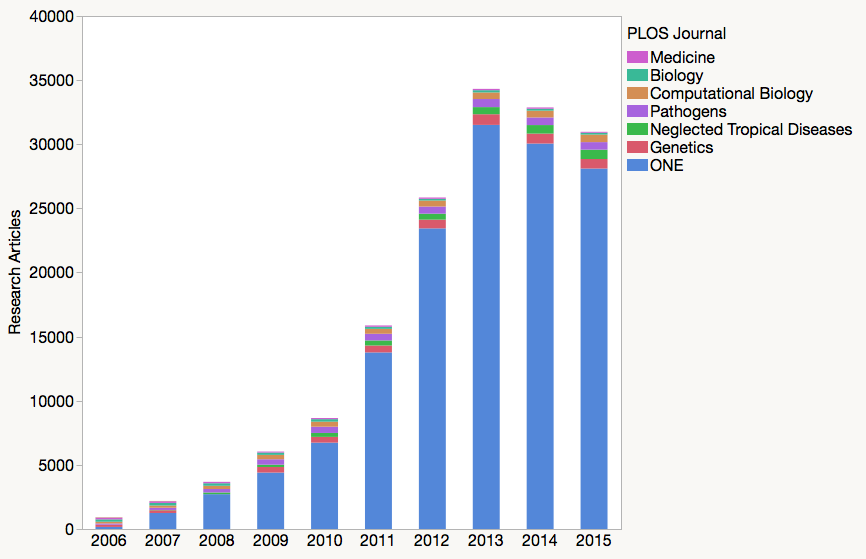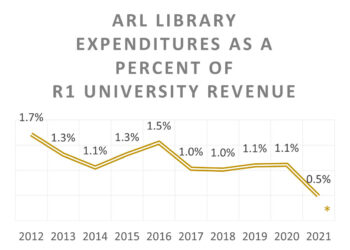For the second year in a row, the number of research papers published in PLOS ONE fell, from a peak of 31,509 in 2013 to 28,107 in 2015 — a decline of 3,402 papers or 11%.
PLOS ONE is still huge, mind you. Indeed, it is the largest journal the world has ever seen. In contrast, output from other PLOS journals looks minuscule by comparison. Taken together, articles published by all other Public Library of Science journals amount to just 9% of total output. PLOS Medicine — one of PLOS’ flagship titles — published just 75 research papers in 2015, amounting to less than one-quarter of one percent (0.24%) of total PLOS output. If you lean forward and squint your eyes, you can barely make out the top sliver of fuchsia from the bar graph below.

As I’ve written extensively over the the past two years (here, here, here, and here), the reduction in PLOS ONE output may be explained by successive falls in its Impact Factor, tighter publication guidelines, a rollback of their no-questions-asked fee waiver, along with competition from other open access multidisciplinary journals. David Crotty has speculated that PLOS’ data access policy, which was revised twice after public outcry and confusion from authors, may have also contributed to a decline in submissions.
The fall in PLOS ONE production has broader implications for its publisher. Surpluses generated from article processing charges help support the publication of PLOS’ more selective journals, like PLOS Medicine, whose 75 research articles in 2015 were accompanied by 19 Essays, 15 Policy Forums, 13 Editorials, 8 Perspectives, 5 Guidelines, 5 Health in Action, 2 Collection Reviews, and 2 Formal Comments. In contrast to research articles, a publisher normally commissions authors to write these papers. Without a cross-subsidy from PLOS ONE, Medicine would not be able to produce this kind of material nor keep its author processing fees below operating costs.
Earlier this year, PLOS sparked conflict with some open access advocates by raising its publication fees for PLOS ONE, but leaving its other journals alone. Combined with a strong US dollar, authors sensitive to publication fees may look for lower cost alternatives.
In addition, Impact Factors fell for all PLOS journals last year (with the exception of Medicine, which grew marginally). As Impact Factor ranks prominently in the minds of submitting authors, performance declines could make it more difficult for PLOS to attract top manuscripts.
Prior to the downturn in 2014, one could look the growth of PLOS ONE and believe that it could go on forever. One could be optimistic and plan for a future of continued growth, new staff, new software, and new office space. Since the vast majority of revenue for PLOS is tied to publication fees, a downturn in output makes all of these investments look less certain.
PLOS ONE was designed to be expandable and expandable it became. Based on the article processing fee model, the publisher generated record income; however, it appears that that this revenue stream has quickly changed directions and is now in decline. A change in research funding levels, competition from higher profile open access journals, as well as from those offering lower-priced alternatives, may make it difficult for the publisher to rely so heavily on PLOS ONE to support its other endeavors.
As PLOS’ primary source of revenue declines, it does not seem to be in a hurry to replace it with other sources beyond price hikes. PLOS hasn’t started a new journal since 2007, and its last innovative attempt at very fast self-publishing (PLOS Currents, 2009) is still very small and generates no revenue. Unless readers can point to developments that I’ve missed, it appears that the future success of PLOS is dependent upon a profitable mega-journal that may not be so mega in the coming years.
Discussion
17 Thoughts on "PLOS ONE Shrinks by 11 Percent"
Another possible factor is that people were submitting to PLOS One because they felt an obligation to support OA. That feeling may be waning, especially given the rise of green OA mandates like the US Public Access program.
To discuss those numbers, it would be useful to see how the number of submitted manuscripts and the rejection (acceptance) rate varied over the last years. Are there any numbers available?
I don’t see why acceptance or rejection rates are related to this discussion since PLOS authors only pay for publication and not submission. I can’t find any public statement of these data anyway.
I think Alexander is trying to make the point that perhaps they have just gotten choosier with their submissions and are therefore publishing less. It makes no difference from the financial front, except that all submitted papers have a cost. I would expect that the acceptance rate is just as high as ever (70% reported in 2013).
Authors tell us in surveys all the time that they prefer to publish their work within their communities. You want to be where your peers are (or where your tenure committee hangs out). Now that just about every journal offers OA and many societies even have a PLOS knock-off, my guess is that competition is “normalizing” the audience. As always happens in technology, the new and shiny service makes a sweep until the next new thing pops up.
I don’t have the exact figures, but I believe the acceptance rate has stayed pretty constant at around 65-70% over the years.
“the number of research papers published in PLOS ONE fell, from a peak of 31,509 in 2013 to 28,107 in 2015 — a decline of 3,402 papers or 11%”
Offset by a 10.7% increase in the APC in 2015………….
And their net assets increased by ~$5M in 2014.
Perhaps another explanation is the number of similar outlets. Checking WoS, you can note the following quite succesful competitors (with their 2015 number of records in WoS noted in brackets): Scientific Reports (9703), SpringerPlus (733), PeerJ (673) and Elife (418).
My view would be, the competition for PloS ONE is on the rise. Especially Scientific Reports an Open Access journal to watch in the years to come.
Good point, Jan. in fact the Scientific Reports numbers are more than enough to account for the PLOS One decline. Note that they say the 2014 Impact Factor for Scientific Reports is 5.578, which I think is much higher than for PLOS One. A formidable competitor. In addition, the SR author requirements look to be much simpler than for PLOS One, which has a lot of burdensome formatting requirements.
In this case there is also competition in APC. Scientific Reports is signficantly cheaper in APC than PloS ONE http://www.nature.com/srep/about/article-processing-charges



